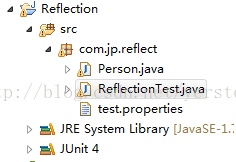Java反射01 反射_Class 反射_Method Annotation
工程截图:
反射操作类:
package com.jp.reflect;
import java.io.InputStream;
import java.lang.annotation.Annotation;
import java.lang.reflect.Field;
import java.lang.reflect.InvocationTargetException;
import java.lang.reflect.Method;
import org.junit.Test;
public class ReflectionTest {
/**
* Annotation 和 反射
* 1、获取Annotation
*
* getAnnotation getDeclaredAnnotations
*
* @throws Exception
*/
@Test
public void testAnnotation() throws Exception {
String className = "com.jp.reflect.Person";
Class clazz = Class.forName(className);
Object obj = clazz.newInstance();
Method method = clazz.getDeclaredMethod("setAge", Integer.class);
int val = 138;
Annotation annotation = method.getAnnotation(AgeValidator.class);
if (annotation != null) {
if (annotation instanceof AgeValidator) {
AgeValidator ageValidator = (AgeValidator) annotation;
if (val < ageValidator.min() || val > ageValidator.max()) {
throw new RuntimeException("年龄非法");
}
}
}
method.invoke(obj, 51);
System.out.println(obj);
}
/**
* @param obj
* :某一类的一对象
* @param methodName
* : 类的一个方法的方法名,该方法可能是私有方法,还可能是该方法在父类中定义的私有方法
* @param args
* : 调用的方法需要传入的参数
* @return 调用方法后的返回值
*/
public Object invoke2(Object obj, String methodName, Object... args) {
// 1.获取Method对象
Class[] parameterTypes = new Class[args.length];
for (int i = 0; i < parameterTypes.length; i++) {
parameterTypes[i] = args[i].getClass();
}
try {
// 2.执行Method方法
// 3.返回方法的返回值
Method method = obj.getClass().getDeclaredMethod(methodName,
parameterTypes);
return method.invoke(obj, args);
} catch (Exception e) {
e.printStackTrace();
}
return null;
}
/**
* 获取clazz的methodName 方法,该方法可能是私有方法,还可能在父类中(私有方法)
*
* @param clazz
* @param methodName
* @param parameterTypes
* @return
*/
public Method getMethod(Class clazz, String methodName,
Class... parameterTypes) {
for (; clazz != Object.class; clazz = clazz.getSuperclass()) {
try {
Method method = clazz.getDeclaredMethod(methodName,
parameterTypes);
return method;
} catch (Exception e) {
e.printStackTrace();
}
}
return null;
}
public void testGetMethod() throws ClassNotFoundException {
Class clazz = Class.forName("com.jp.reflect.Student");
Method method = getMethod(clazz, "method1", Integer.class);
System.out.println(method);
// method = getMethod(clazz, "method2");
// System.out.println(method);
}
public void testInvoke2() {
Object obj = new Student();
// Student 类的method1()方法被调用,打印"private void method1"
invoke2(obj, "method1", 10);
// Student 类的父类的method2()方法被调用,返回值为"private String method2"
Object result = invoke2(obj, "method2");
System.out.println(result);
}
/**
* 若通过 Method 的invoke() 方法调用方法,而访问权限不足,则可以先使该方法变为可被 访问的方法。
*
* @throws NoSuchMethodException
* @throws SecurityException
* @throws IllegalAccessException
* @throws IllegalArgumentException
* @throws InvocationTargetException
*/
public void testInvokePrivateMethod() throws NoSuchMethodException,
SecurityException, IllegalAccessException,
IllegalArgumentException, InvocationTargetException {
Object obj = new Student();
Class clazz = obj.getClass();
Method method = clazz.getDeclaredMethod("method1", Integer.class);
System.out.println(method);
// 若血药通过反射执行私有方法
method.setAccessible(true);
method.invoke(obj, 10);
}
/**
* 获取当前类的父类: 直接调用Class 对象的getSuperclass() 方法
*
* @throws ClassNotFoundException
*
*/
public void testGetSuperClass() throws ClassNotFoundException {
String className = "com.jp.reflect.Student";
Class clazz = Class.forName(className);
Class superClazz = clazz.getSuperclass();
System.out.println(superClazz);
}
/**
* @param className
* : 某个类的全类名
* @param methodName
* : 类的一个方法的方法名
* @param args
* : 调用的方法需要传入的参数
* @return 调用方法后的返回值
*/
public Object invoke(String className, String methodName, Object... args) {
Object obj = null;
try {
obj = Class.forName(className).newInstance();
return invoke(obj, methodName, args);
} catch (Exception e) {
e.printStackTrace();
}
return null;
}
/**
* @param obj
* : 执行方法的对象
* @param methodName
* : 类的一个方法的方法名,该方法可能是私有方法
* @param args
* : 调用的方法需要传入的参数
* @return 调用方法后的返回值
*/
public Object invoke(Object obj, String methodName, Object... args) {
// 1.获取Method对象
Class[] parameterTypes = new Class[args.length];
for (int i = 0; i < parameterTypes.length; i++) {
parameterTypes[i] = args[i].getClass();
}
try {
// 2.执行Method方法
// 3.返回方法的返回值
Method method = obj.getClass().getDeclaredMethod(methodName,
parameterTypes);
return method.invoke(obj, args);
} catch (Exception e) {
e.printStackTrace();
}
return null;
}
public void testInvoke() {
Object obj = new Person();
invoke(obj, "setName", "Jason", new Integer(1));
invoke("com.jp.reflect.Person", "setName", "Jason", new Integer(12));
// Object result = invoke("java.text.SimpleDateFormat", "format",
// new Date());
// System.out.println(result);
}
/**
* Class 是对一个类的描述 类的属性: Field 类的方法:Method 类的构造器:Constructor
*
* Method:对应类中的方法。
*
* 1、获取Method
*
* 1.1、获取类的数组:clazz.getDeclaredMethods
*
* 1.2获取类的指定的方法:clazz.getDeclaredMethod(String name, Class<?>...
* parameterTypes)
*
* 1.3通过Method对象执行方法: method.invoke(Object obj, Object... args) obj执行那个对象的方法
*
*/
public void testMethod() throws Exception {
Class clazz = Class.forName("com.jp.reflect.Person");
// 1.得到clazz对应的类中有哪些方法,不能获取private方法
Method[] methods = clazz.getMethods();
for (Method method : methods) {
System.out.println("^" + method.getName());
}
// 2.获取所有的方法,包括private方法,且至获取当前类声明的方法
Method[] methods2 = clazz.getDeclaredMethods();
for (Method method : methods2) {
System.out.println("~" + method.getName());
}
// 3.获取指定的方法(指定参数)。
Method method = clazz.getDeclaredMethod("setName", String.class);
System.out.println(method);
method = clazz.getDeclaredMethod("test");
System.out.println(method);
method = clazz
.getDeclaredMethod("setName", String.class, Integer.class);
System.out.println(method);
// 4.执行方法
Object obj = clazz.newInstance();
method.invoke(obj, "jack", 12);// 参数1 执行那个对象的方法
}
public void testClassLoader() throws ClassNotFoundException {
// 1.获取一个系统的类加载器
ClassLoader classLoader = ClassLoader.getSystemClassLoader();
System.out.println(classLoader);
// 2.获取系统类加载器的父类加载器
classLoader = classLoader.getParent();
System.out.println(classLoader);
// 3.获取扩展类加载器的父类加载器
classLoader = classLoader.getParent();
System.out.println(classLoader);
// 4.测试当前类是由那个类加载器进行加载的
classLoader = Class.forName("com.jp.reflect.ReflectionTest")
.getClassLoader();
System.out.println(classLoader);// 引导类加载器,无法直接获取,打印null
// 5.测试JDK提供的Object类有哪个类加载器负责加载
classLoader = Class.forName("java.lang.Object").getClassLoader();
System.out.println(classLoader);
// 6.关于类加载器的一个主要方法。
// 调用getResourceAsStream方法 获取类路径下文件对应的数据流
// this.getClass().getClassLoader()系统加载器
InputStream in = this.getClass().getClassLoader()
.getResourceAsStream("com/jp/reflect/test.properties");
System.out.println(in);
// new FileInputStream("test.properties");
}
/**
* Class类的newInstance()方法
*
* @throws ClassNotFoundException
* @throws IllegalAccessException
* @throws InstantiationException
*/
public void testNewInstance() throws ClassNotFoundException,
InstantiationException, IllegalAccessException {
String className = "com.jp.reflect.Person";
Class clazz = Class.forName(className);
// 利用Class 对象的newInstance()方法创建类的一个实例
// 调用类的无参构造器
// 一般的,一个类若声明了带参数的构造器,也要声明一个无参数的构造器
Object obj = clazz.newInstance();
System.out.println(obj);
}
/**
* 关于Class:
*
* 1、Class是一个类
*
* 2、对像照镜子后可以得到的信息,类名、属性、方法、实现接口,继承父类
*
* 一个类在JVM中只有一个Class实例
*
* @throws ClassNotFoundException
*
*/
public void testClass() throws ClassNotFoundException {
Class clazz = null;
// 1、得到Class 对象
// 1.1直接通过 类名.class 的方式得到
clazz = Person.class;
Field[] fields = clazz.getDeclaredFields();
// 1.2通过对象调用getClass()方法来获取
Object obj = new Person();
clazz = obj.getClass();
// 1.3通过类的全类名获取
String className = "com.jp.reflect.Person";
clazz = Class.forName(className);
}
}
package com.jp.reflect;
public class Person {
String name;
Integer age;
public Person(String name, int age) {
super();
this.name = name;
this.age = age;
System.out.println("有参数构造器");
}
public Person() {// 留给反射使用
super();
System.out.println("无参数构造器");
}
private void test() {
}
public String getName() {
return name;
}
public void setName(String name, Integer age) {
System.out.println("name:" + name);
System.out.println("age:" + age);
}
public void setName(String name) {
this.name = name;
}
public int getAge() {
return age;
}
@AgeValidator(min = 18, max = 35)
public void setAge(Integer age) {
this.age = age;
}
private String method2() {
return "private String method2";
}
@Override
public String toString() {
return "Person [name=" + name + ", age=" + age + "]";
}
}
package com.jp.reflect;
import java.lang.annotation.ElementType;
import java.lang.annotation.Retention;
import java.lang.annotation.RetentionPolicy;
import java.lang.annotation.Target;
@Retention(RetentionPolicy.RUNTIME)
@Target(value = { ElementType.METHOD })
public @interface AgeValidator {
public int max();
public int min();
}声明:该文观点仅代表作者本人,入门客AI创业平台信息发布平台仅提供信息存储空间服务,如有疑问请联系rumenke@qq.com。
- 上一篇:没有了
- 下一篇:没有了


